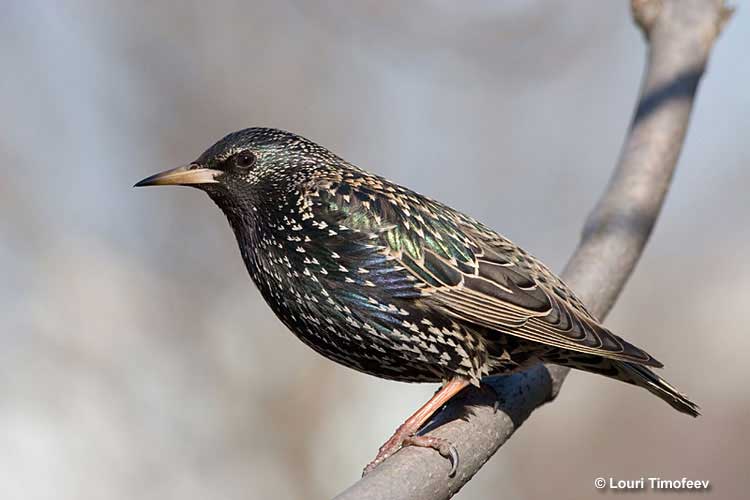
One of the wonderful things about birds is that they live everywhere! We don’t have to travel far to see lots of beautiful birds. In fact, plenty of beautiful birds live right in the backyard!
Backyards throughout the eastern USA are highlighted by the cheery songs and bright red plumage of Northern Cardinals. Eastern backyards also see visits from beautiful Blue Jays, while westerners are treated to the deep sapphire plumage of Steller’s Jays.
We can enjoy dozens of other birds too, all while relaxing with a hot tea or fresh, steaming coffee. Enjoying backyard birds is the perfect way to reset and begin the day on a fantastic, positive note.
Which are the most common backyard birds in your neighborhood? See this article to learn all about the most common backyard birds!
Birds Every Bird Friend Should Know
American Goldfinch
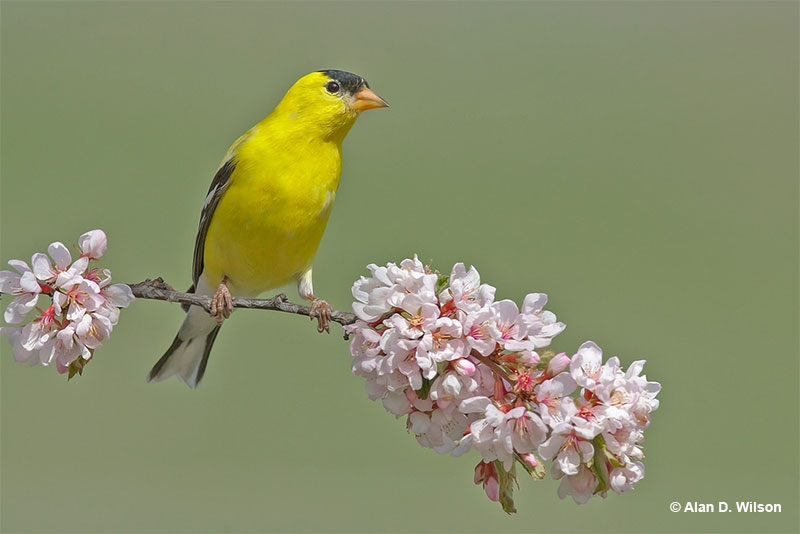
American Goldfinches are gorgeous little birds that love to visit big gardens. These small finches can also frequent smaller backyards but prefer gardens with plenty of space. Pairs can show up but small flocks are more typical, especially in backyards with Thistle and other plants that they feed on.
These little birds mostly eat small seeds that they eat while perched on sunflowers, other low plants, and feeders.
Typically, when goldfinches arrive, we hear their fun “per-chickery!” call. They vocalize as they swoop into the backyard with bounding flight.
In summer, American Goldfinches visit backyards in southern Canada and a large part of the eastern and northern USA. In winter, they occur in most of the USA and some parts of southern Canada.
Mourning Dove
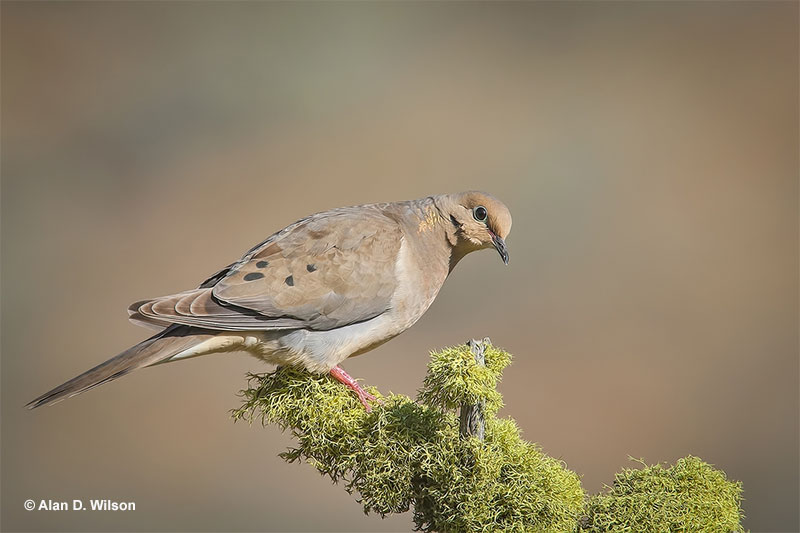
Mourning Doves are lovely birds that grace backyards of all sizes. If you hear a bird making sad, low-pitched calls and wonder if you might be hearing an owl, it’s probably one of these beautiful doves!
In the morning, we often hear this species as it calls from tall pines and other backyard trees. They also like to visit feeders and in many North American backyards, Mourning Doves are the most common dove.
This species likes to pick small seeds from the ground underneath feeders but can also perch on the feeder as it eats.
We usually see Mourning Doves in pairs or small flocks and find them in backyards all year long, throughout the lower 48 states and parts of southern Canada.
Northern Cardinal
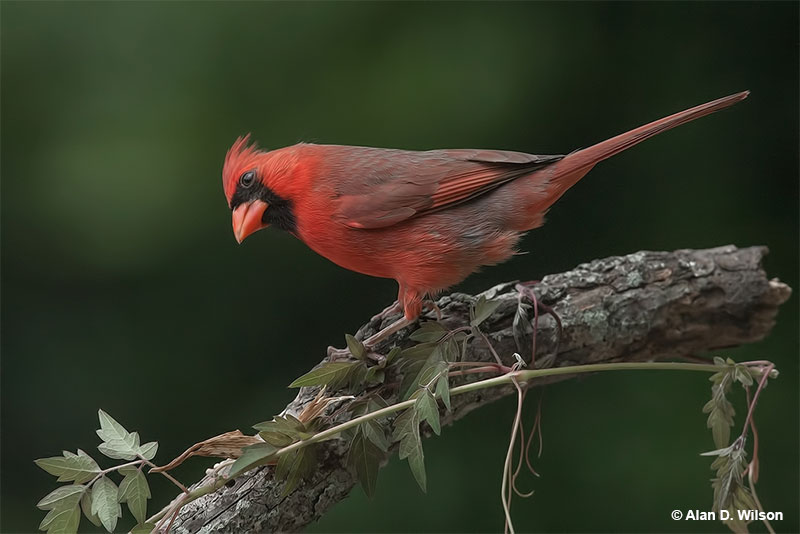
Northern Cardinals might win the prize for being the most beautiful backyard bird. There are a lot of contenders, but it’s hard to compete with a striking bright red, crested bird with a jet-black mask!
Even better, this breathtaking species is common! Northern Cardinals love backyards with dense shrubbery and trees. They nest there and also forage in this habitat for bugs and seeds.
Male Northern Cardinals sing their pretty whistled songs from bushes as well as from backyard trees and even from the tops of houses.
Related: Bird watching for beginners (incl. what to bring)
Pairs of this lovely species also visit feeders to feed on sunflower seeds, especially in the morning and late afternoon.
We enjoy Northern Cardinals all year long in southeastern Canada, and in the eastern and southwestern USA.
American Robin
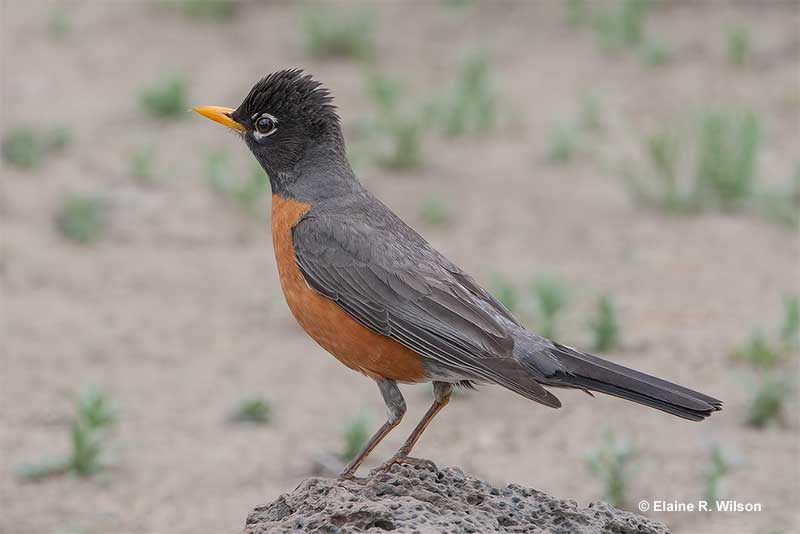
American Robins are common thrushes welcome in every backyard. It’s a joy to watch pairs of these lovely birds forage for worms on fresh green lawns!
We also enjoy the male’s beautiful caroling song. As he sings from a neighborhood tree, the male tells us that spring has arrived and that we can expect robin nests in our backyard trees and bushes.
These beautiful, familiar birds are resident in summer, but by fall and winter, most American Robins form flocks that feed on fruiting trees in rural areas. Birds from northern regions also migrate south.
Instead of visiting feeders, American Robins look for bugs and worms in open areas. This handsome bird lives in Alaska, most of Canada, and throughout the USA south to Mexico.
Blue Jay
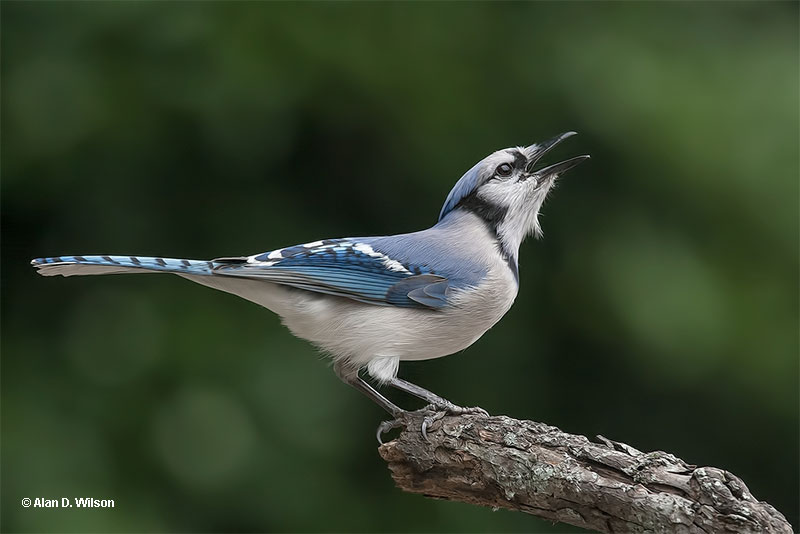
Blue Jays are one of the boldest of beautiful backyard birds. When Blue Jays are present, we can’t help but hear their loud, varied vocalizations issuing from maples, oaks, and other tall backyard trees.
These smart birds are also frequent at backyard feeders. Put out some acorns and peanuts and it won’t be long before a pair of Blue Jays comes in to investigate!
If you have a tall tree or two, they might also nest high above your backyard. These omnivores can also attack the nests of other birds.
This beautiful bird is a common, year-round resident in the eastern USA, and in parts of central and southern Canada. In winter, many Blue Jays also migrate to Florida, southern Texas, and the northwestern states.
Downy Woodpecker
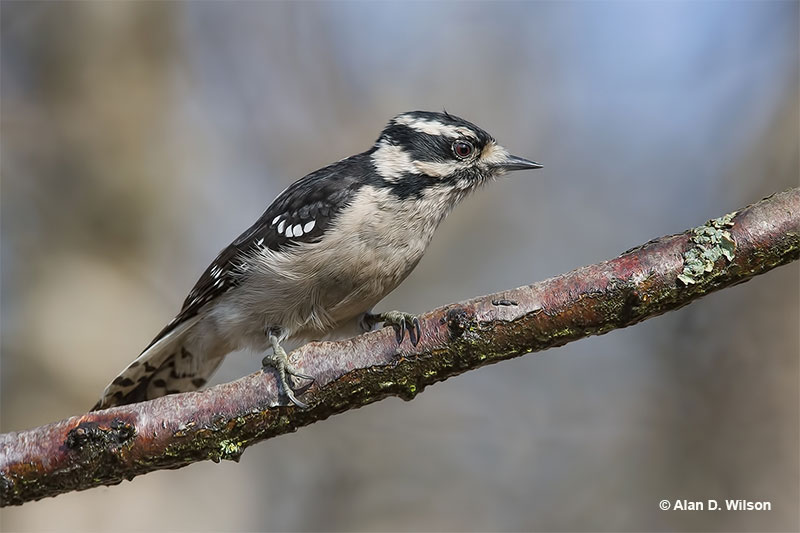
Female Downy Woodpecker
Woodpeckers are backyard birds too, and the Downy Woodpecker is one of the most common. This sparrow-sized woodpecker loves to visit backyards with trees of all sizes. Pairs forage on those trees as well as in bushes for bugs and other small creatures.
If one of your trees has a dead branch, these pretty little woodpeckers might also nest in the backyard.
Downy Woodpeckers are also frequent at feeders, especially feeders with suet, peanuts, and seeds. They almost always occur as pairs and if another Downy Woodpecker shows up, they will probably chase it away.
This small woodpecker is a year-round resident in parts of Alaska, much of Canada, and in most of the USA. It’s absent from arid habitats in the southwestern USA.
House Finch
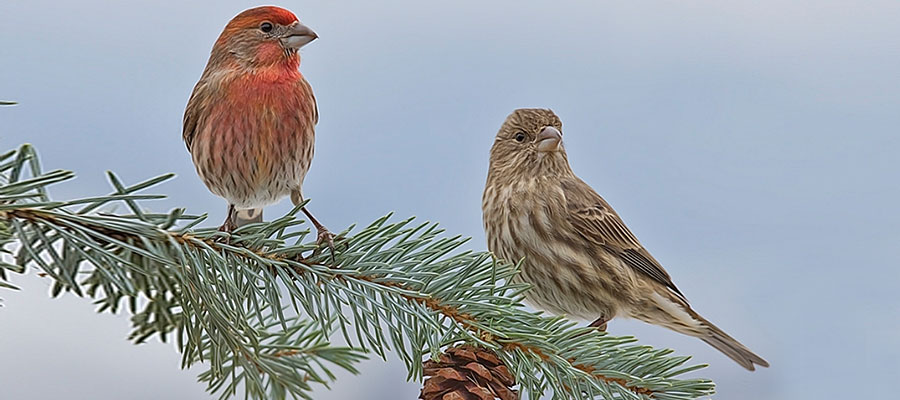
House Finches are lovely, rose-colored birds with beautiful rambling songs. What a great bird to have in the backyard!
These sparrow-sized finches have become very much adapted to living near people and occur in all sorts of backyards and gardens. We might hear a male singing from a tall tree, see pairs coming to the feeder, or find them nesting on lodges and other spots.
They are happy to visit feeders to eat seeds but also forage on the ground and in bushes for bugs. Like other backyard birds, House Finches also enjoy bird baths.
House Finches occur all year long in some parts of southern Canada, most of the eastern USA, and in most parts of the western USA.
Hummingbirds
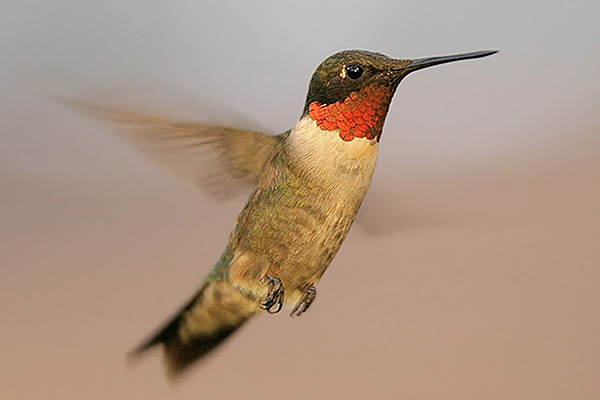
Photograph © Greg Lavaty.
Hummingbirds also visit backyards, and in some places, many of them! Big backyards in the eastern USA and southern Canada can host Ruby-throated Hummingbirds.
In migration, dozens of hummingbirds might occur while females might stay to nest in early summer. Other parts of the USA host additional hummingbird species, with the highest number living in Arizona and adjacent New Mexico.
Backyard hummingbirds spend most of their time taking nectar from feeders and bushes with small tubular flowers. However, they also love to bathe, especially at red water features!
At least one hummingbird species occurs in most parts of the USA and southern Canada. Most are summer residents, although Anna’s Hummingbirds and hummingbirds in the American Southwest can occur all year long.
Northern Mockingbird
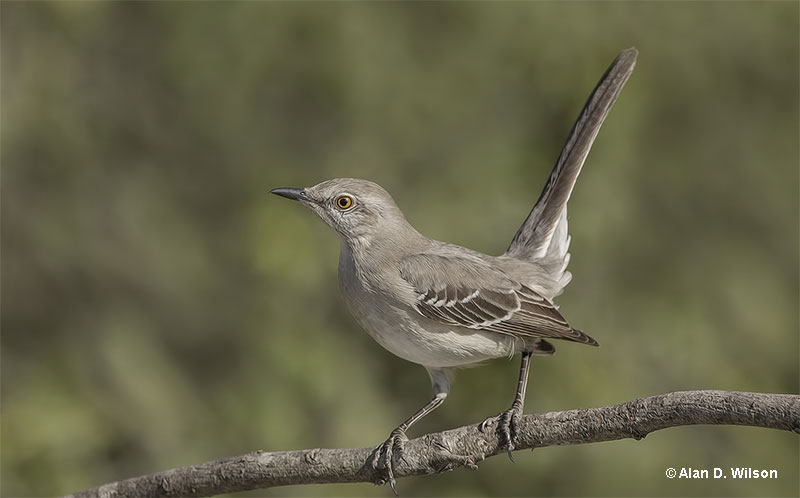
Northern Mockingbirds are another bold and common backyard bird. These long-tailed birds are best known for their singing capabilities; something you become quickly aware of when one lives in the neighborhood!
Male mockingbirds seem to love center stage. In backyards, they sing their complex songs from the tops of houses and other conspicuous spots, at all times of the day, and even in the middle of the night!
We also see Northern Mockingbirds foraging for insects on lawns and other open spots. They often chase other birds and can nest in backyard shrubbery, especially in Multiflora Rose.
Northern Mockingbirds are year-round residents in some parts of southern Canada and throughout the lower 48 states. They also range into the Caribbean and Mexico.
Carolina Wren
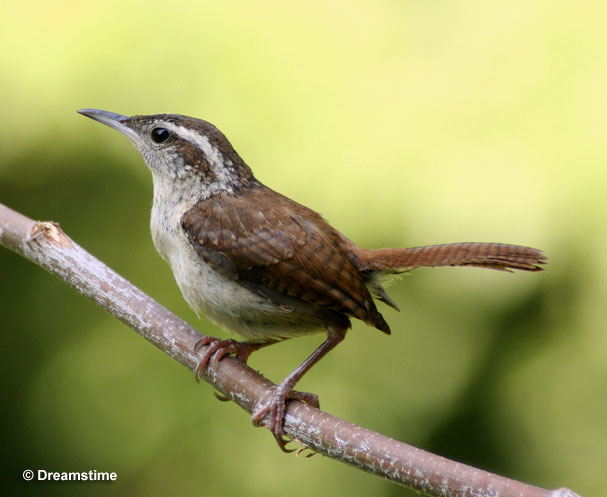
Carolina Wrens are another very vocal species that fills backyards with cheerful, ringing birdsong. However, they aren’t nearly as bold as American Robins or Northern Mockingbirds.
These birds are a lot more reclusive and prefer to stay in dense shrubbery, vine tangles, and other thick foliage. With that in mind, it’s no surprise that Carolina Wrens tend to be more frequent in big backyards with plenty of vegetation.
They won’t come to feeders, but we can locate them by their frequent vocalizations and as they forage for bugs in the foliage.
Carolina Wrens are year-round residents in a few areas in southeastern Canada and much of the eastern USA. They are most common in regions with mild winters, especially from southern New Jersey to Florida.
Tufted Titmouse
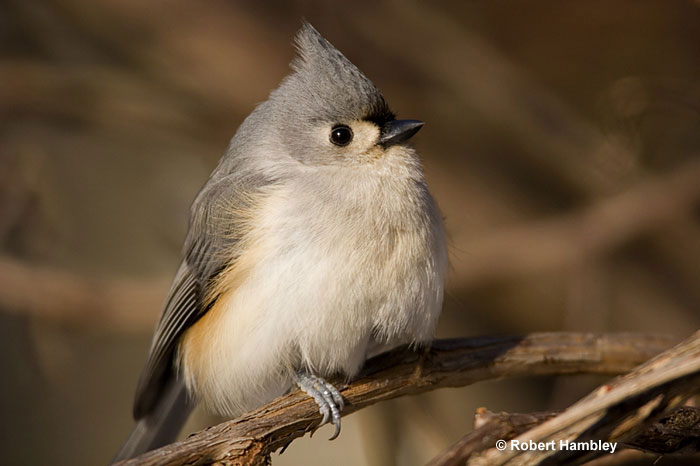
The Tufted Titmouse is one of the cutest of the backyard birds. This little crested bird prefers big backyards, especially ones in suburban areas where there are lots of mature trees.
Small family flocks of Tufted Titmice come into backyards to forage for bugs, nuts, and other bits of food, especially in oak trees. They also come to feeders for sunflower seeds, nuts, and suet but mostly during the winter months.
This species can also nest in backyards with big trees and in nesting boxes. When titmice are around, we usually hear them first. They often give a simple, easily imitated whistled song, “peter peter peter”.
The Tufted Titmouse occurs in some parts of southeastern Canada but mostly lives in the eastern USA.
American Crow
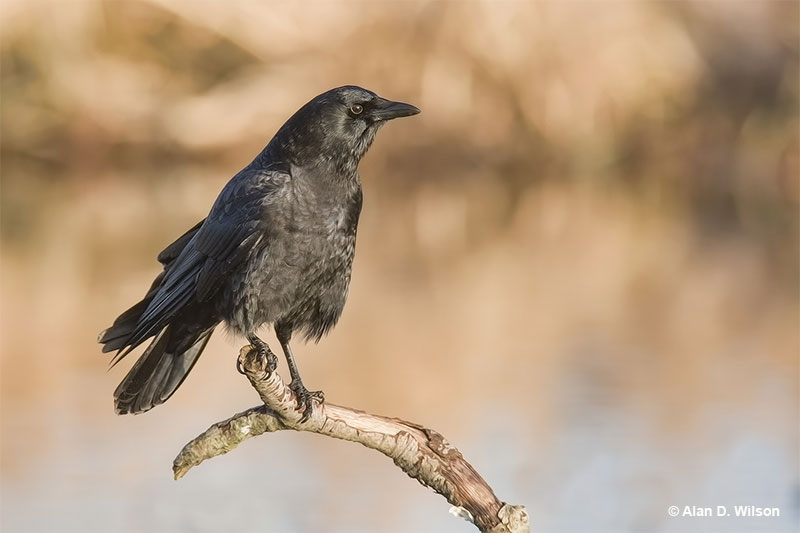
American Crows are one of the biggest backyard birds. They might not be pretty but these Corvids have fascinating behaviors.
This smart species has adapted to living with people but tends to be a lot more cautious than smaller birds. In the backyard, we usually hear their loud “cawing’ calls before laying eyes on them, and mostly see crows as they fly overhead.
However, they can also visit and even nest in backyards with tall trees. American Crows don’t often visit feeders but pairs and small flocks can pick at garbage or take advantage of other feeding situations.
This successful bird lives in southern Alaska, large parts of Canada, and in most of the USA. Northern birds migrate to milder areas for the winter.
European Starling
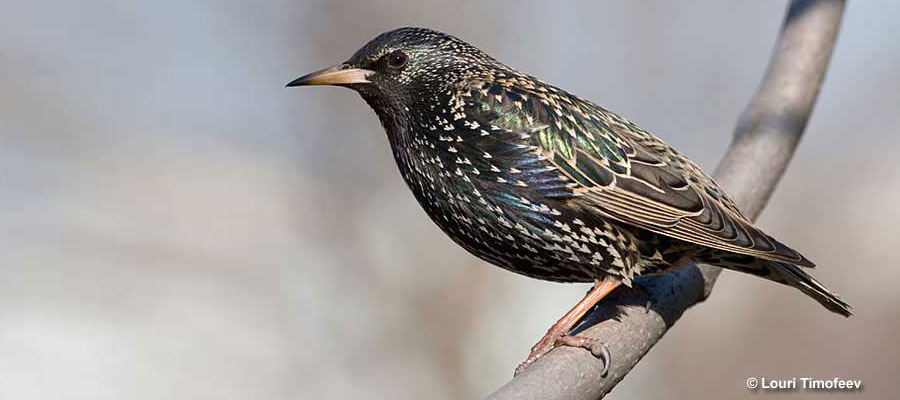
European Starlings are interesting backyard birds that don’t resemble anything else in North America. Introduced from Europe more than a century ago, they have become well adapted to urban and suburban situations.
Although this bird prefers parks, golf courses, and open lawns and fields, we also see them on city streets and in all sorts of gardens and backyards.
European Starlings can sing their odd-sounding songs from the tops of backyard trees, and can nest in the eaves of houses and in backyard tree cavities. We can also see small flocks forage on the ground for bugs and worms as well as eating seeds at feeders.
This species lives year round in much of southern Alaska, Canada, and the lower 48 states.
House Sparrow
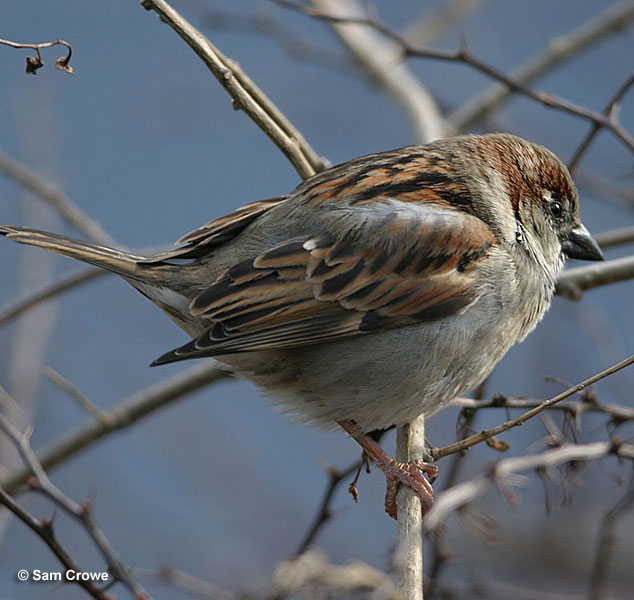
In most backyards, the House Sparrow is the most common bird species. This little bird might be native to Eurasia but it has no problem living with people in many other parts of the world too.
House Sparrows are right at home in backyards and they also love feeders! These sparrows forage for seeds and bugs on the ground but can also perch on feeders with sunflower and other seeds.
This species can also perch in bushes and commonly nests on house eaves, and in nest boxes and other cavities.
The chirping of this familiar bird is a regular sound in streets and backyards in many places. In North America, they occur near people in much of Canada and much of the lower 48 states.
Red-bellied Woodpecker
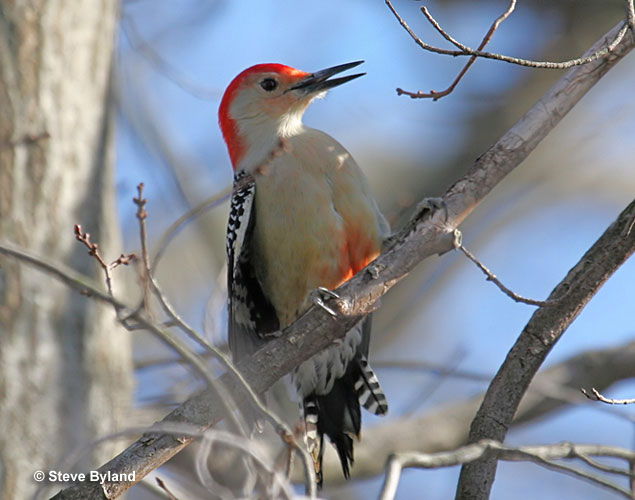
In the eastern USA, the Red-bellied Woodpecker is one of the most common woodpecker species. This beautiful bird has become accustomed to living in many suburban areas and even urban places with big trees.
It usually visits larger backyards and gardens that have some big trees, but it wouldn’t be surprising to see it in smaller backyards too. Red-bellied Woodpeckers call from big trees and also forage on them for insects, nuts, and fruit.
They also visit feeders. Put out some peanuts and suet and this striking bird will probably make an appearance!
This species can also nest in backyards that have big trees with dead branches. We find Red-bellied Woodpeckers in much of the eastern USA and in southeastern Canada.
Song Sparrow
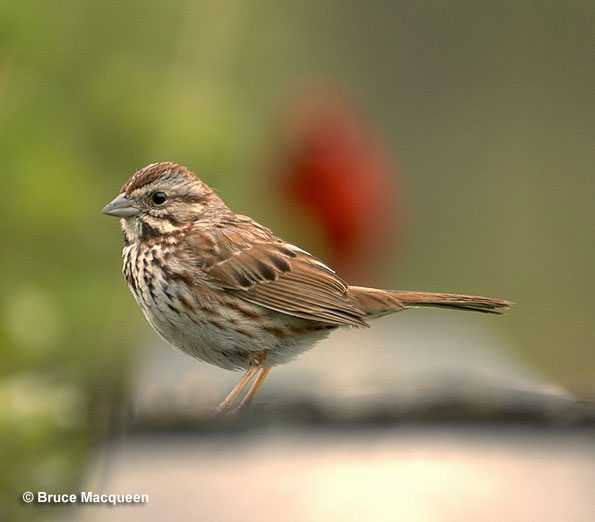
If you see a streaked sparrow in the backyard, it’s probably this common species. Song Sparrows like brushy areas, especially near water, but can also occur in big backyards.
This sparrow forages for insects and seeds in and near dense shrubbery. True to its name, males also frequently sing a cheerful song of warbled and trilled notes from the tops of bushes.
If your garden is big enough and has lots of shrubbery, Song Sparrows might also nest there. Whether they nest in the garden or not, these sweet little birds will pick seeds from underneath feeders, especially in the winter.
Song Sparrows breed in Canada, southern coastal Alaska, and in the northern and western USA. They winter in most of the USA and parts of southern Canada.
Spotted Towhee
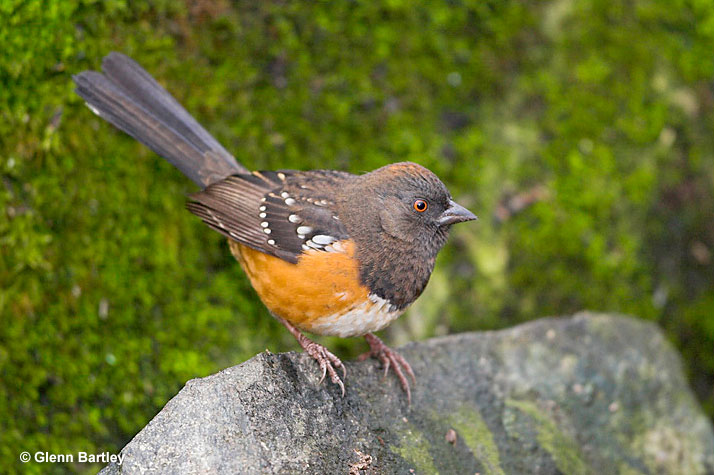
These pretty, finch-like birds are a welcome addition to any garden! They mostly occur in thicket habitats outside of urban areas. However, they sometimes visit backyards near shrubby areas.
Spotted Towhees can also nest in big backyards with lots of dense shrubs. We usually see this species foraging on and near the ground for insects and seeds. However, when singing their trilled song, they can also perch on top of bushes.
These handsome sparrows can also visit feeders where they usually pick up seeds from the ground.
Spotted Towhees can grace backyards in parts of western Canada and in much of the western USA. Birds from the northern parts of their range migrate south and can winter in Texas and east to Kansas.
Carolina Chickadee
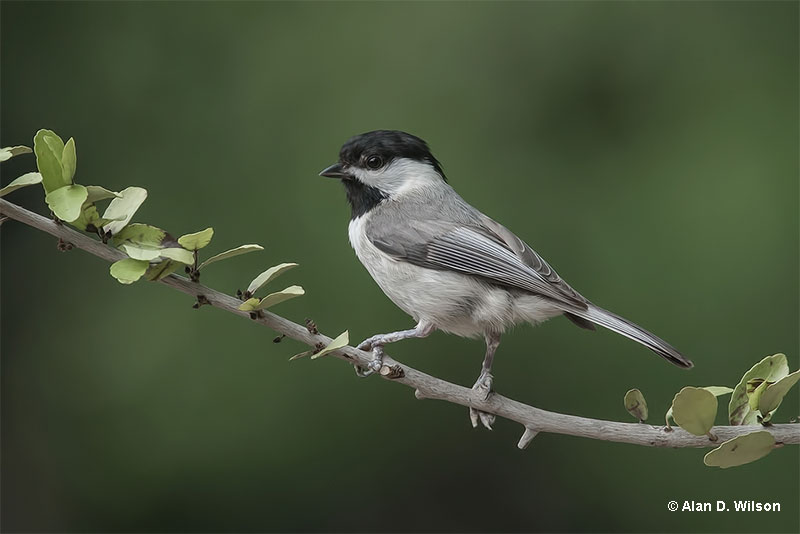
Carolina Chickadees are common and welcome birds throughout their range. Like their Black-capped cousins, these cute little birds don’t have any problem visiting big gardens and backyards.
They usually occur in small chattering flocks that move through trees and bushes in search of small insects and other bits of food. In backyards with big trees, this species can also nest in tree cavities and next boxes.
Carolina Chickadees are regular at the bird feeder too. They eat various seeds as well as suet.
When this species comes through the garden, keep an eye out for kinglets, nuthatches, and other small birds that frequently flock with them.
Carolina Chickadees are enjoyed all year long in the southeastern USA, north to Ohio and New Jersey.
Cedar Waxwing
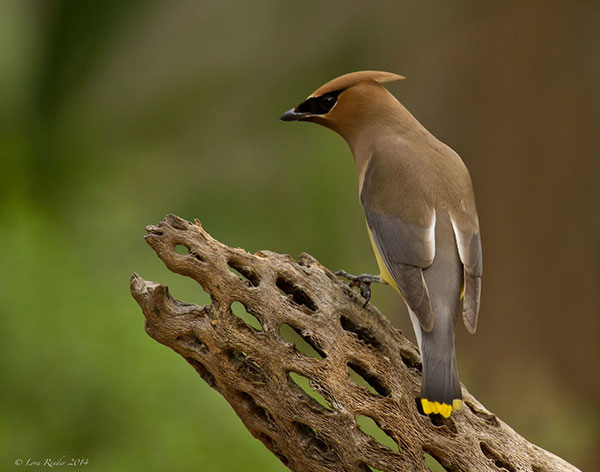
Cedar Waxwings are backyard birds that don’t visit feeders. Instead, they feed on fruiting bushes and trees.
These lovely birds move around in flocks in search of fruiting mulberries, cedars, and various other trees. When they find a good crop, they can stay for a while, especially during the winter.
In summer, Cedar Waxwings can also nest in backyards that have tall trees. At that time of year, we also see these sleek birds sally into the air to catch flying insects!
To know when Cedar Waxwings are around, listen for their high-pitched, lazy trilling or wheezing calls.
This pretty bird breeds in much of Canada and the northern USA. In winter, northern birds migrate to much of the USA.
Common Grackle
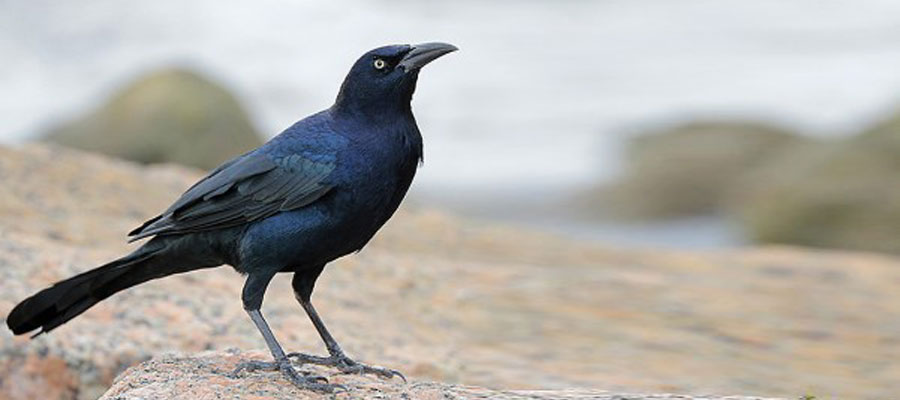
East of the Rockies, the Common Grackle tends to be the most common, all dark blackbird species. These pretty, iridescent birds can occur in urban areas but are more frequent in the suburbs and around country homes.
Common Grackles also prefer larger backyards that have extensive lawns where they can walk and forage for worms and bugs. Pairs and small flocks occur and also eat seeds at feeders.
We also commonly hear their squeaky songs as they sing from bushes, trees, or even the ground. Common Grackles are a common backyard bird species in many areas of Canada and the USA east of the Rocky Mountains.
Birds that live in western and northern regions mostly winter in the eastern USA.
Hairy Woodpecker
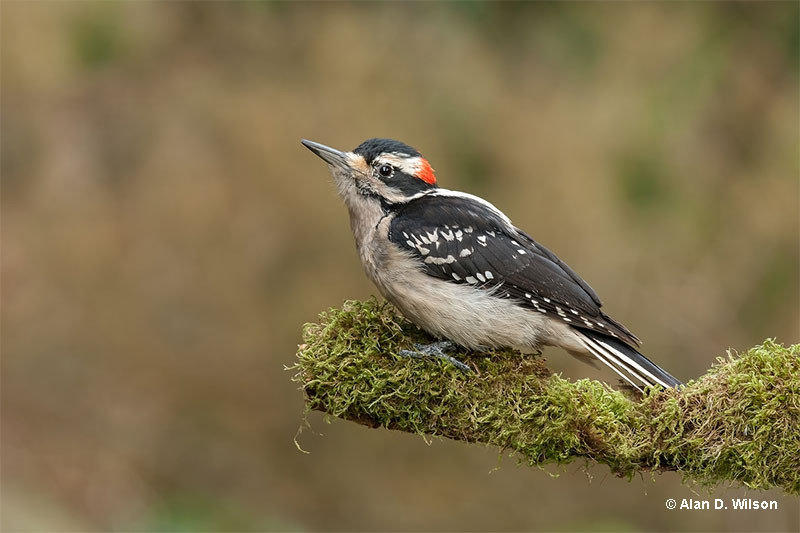
This species is one of the other main woodpeckers commonly seen in backyards. Hairy Woodpeckers tend to be woodland birds, but as long as mature trees are present, they can also visit backyards.
Pairs of this woodpecker species likes to forage on big trunks and also excavate nesting holes on those same trees. Much to our good fortune, these striking woodpeckers also visit feeders. They can feed on some seeds and nuts but really love suet.
We usually know when a Hairy Woodpecker is nearby when the bird makes its loud and sharp “peek!” call, or similar rattling vocalizations.
Hairy Woodpeckers are year-round residents with large ranges that extend from Alaska and Canada to much of the USA.
Oak Titmouse
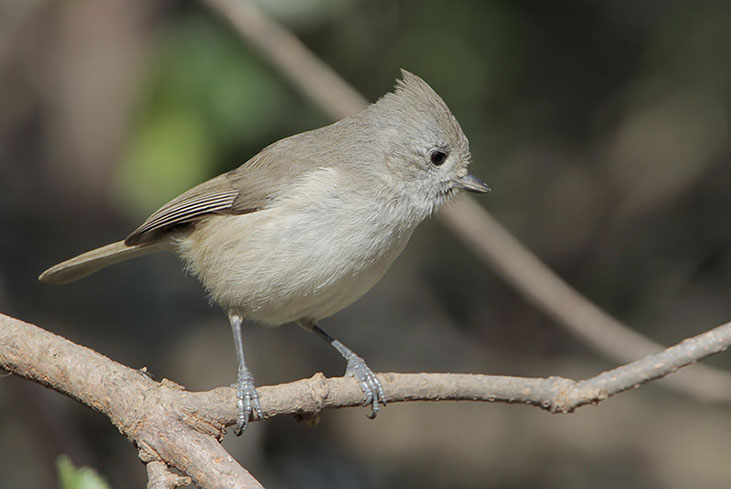
The Oak Titmouse is one of the common backyard birds of California. As long as your California backyard has oak trees, this species is probably present. These cute little birds prefer to forage on branches and in foliage for insects but they can also come to feeders.
They tend to be submissive to other birds, but when they see their chance, they will visit the feeder for seeds, bits of peanuts, and suet.
When they aren’t foraging, Oak Titmice reminds us of their presence with distinctive, sharp, double-noted calls.
As long as tree cavities are present, these sweet little birds can also nest in the backyard. These year-round residents are almost entirely restricted to dry oak woodlands and similar habitats in California.


Thomas DRAZKOWSKI
Wednesday 10th of January 2024
Your @downy woodpecker is actually a @hairy woodpecker, downy has a shorter beak.
Sam Crowe
Tuesday 16th of January 2024
You are correct; not sure why it was named as Downy Woodpecker in our media library!